Roku Not Connecting to Internet
In today’s streaming-centric world, devices like Roku have become essential for households looking to access a wide variety of entertainment options, from the latest movies and TV shows to news & sports, all available at the click of a button. Roku devices are celebrated for their simplicity and an extensive array of streaming channels, but they are not without their technical hitches. A common challenge that Roku users may encounter is Roku not connecting to the internet, which can significantly hinder their streaming experience.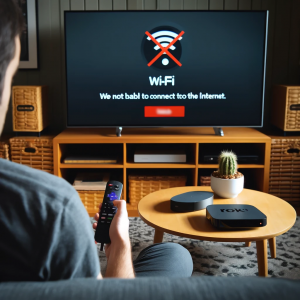
If you find your Roku not connecting to WiFi or you receive messages that your Roku does not connect to the internet, you’re not alone. These problems can stem from various factors such as network settings, hardware problems, or temporary service disruptions. Understanding the root cause is the initial step to resolve these frustrating interruptions.
This guide is specifically crafted to help Roku users who are struggling with Roku not connecting to WiFi issue. Whether your Roku is not connecting, or you are facing more specific problems that leave your Roku unable to access the internet, this article will provide detailed troubleshooting techniques. By following this step-by-step guide, you’ll be equipped to diagnose and resolve the most common Roku connectivity issues affecting your device, ensuring you can get back to enjoy your favorite content without any hassle.
Understanding Your Roku’s Internet Needs
To enjoy ininterrupted streaming on your Roku device, understanding its internet requirements is crucial that can avoid Roku connectivity issues. Roku devices, designed to bring a wealth of media content into your living room, demand a specific internet setup to function optimally. This includes not only the type of connection but also the speed at which your internet runs.
-
Internet Speed for Roku and Connection Type
The ideal internet speed for Roku devices varies depending on the content quality you wish to access. For standard definition (SD) content, speeds of at least 3 Mbps are recommended. However, if you’re aiming to stream high-definition (HD) content or indulge in the crisp details of 4K Ultra HD, you’ll need considerably more bandwidth—usually around 25 Mbps for 4K content. It’s also beneficial to have an internet connection that can handle these speeds consistently, especially if multiple devices are connected simultaneously.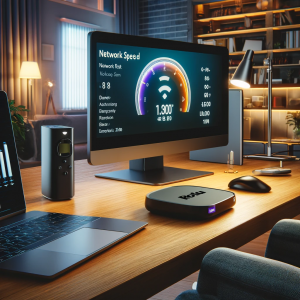
Roku devices can establish an internet connection via WiFi or through a wired Ethernet connection. While WiFi is sufficient for most households, a wired connection can offer more stability and speed, particularly important for streaming high-quality video without buffering.
-
Importance of a Stable Connection for Roku
A reliable internet connection is vital when using Roku. Roku connection issues can manifest as frequent buffering, poor video quality, and even interruptions during your streaming experience. These Roku connection issues can stem from fluctuating speeds, which are often due to network congestion or inadequate router performance.
To mitigate such issues, ensure that your WiFi router is up to date and capable of supporting the speeds your internet provider offers. Positioning your Roku device closer to your router or using a WiFi extender can also improve signal strength.
By meeting these internet requirements and ensuring a stable connection, you can dramatically improve your Roku streaming experience, reducing the likelihood of Roku connectivity issues and enjoying your favorite content without interruption.
Common Causes for Roku Connectivity Issues
When you encounter issues where your Roku is not connecting to the internet, it disrupts your ability to stream your favorite content. Various factors can lead to Roku connectivity problems, and understanding these can help you quickly get back to your shows and movies. Here are some common reasons why your Roku is not connecting to WiFi or the internet:
-
Weak Wireless Signal
A weak or unstable WiFi signal is a common culprit behind issues like Roku not connecting to WiFi. If your Roku device is placed too far from your router, or if there are physical barriers such as walls or furniture, it could significantly weaken the signal. Additionally, interference from other wireless devices in your home, such as microwaves or cordless phones, could impact your Roku’s ability to connect to WiFi.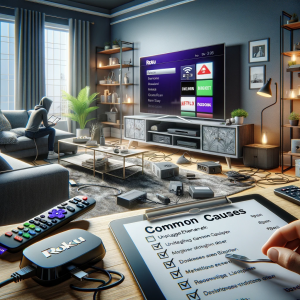
-
Network Congestion
Roku will not connect to WiFi when many devices are using your home network simultaneously. This network congestion can monopolize bandwidth, especially if multiple devices are streaming video, leading to problems where your Roku will not connect to WiFi while other devices may not exhibit the same connectivity issues.
-
Incorrect Network Settings
If your Roku is not connecting to WiFi, it could be due to improper network settings. This might involve entering the wrong WiFi password, choosing the incorrect network, or needing to refresh outdated network settings.
-
Router Issues
Router-related issues can also cause problems such as Roku not connecting to WiFi. Sometimes, the router may need a firmware update or a quick restart to resolve internal errors and restore a proper connection.
-
DNS Settings
Incorrect DNS settings can lead to situations where Roku will not connect to WiFi. Adjusting your router’s DNS settings to a more reliable server like Google DNS or OpenDNS might resolve these Roku connectivity issues.
-
Roku Software Glitches
Software glitches within the Roku device itself can also result in Roku not connecting to WiFi issue. Performing a system restart or factory reset on the Roku can help fix these glitches, potentially resolving scenarios where Roku will not connect to the internet.
-
Service Provider Outage
Sometimes, the problem is outside your control, such as a service outage from your ISP. If there is a widespread outage, your Roku device, along with other devices, might not connect to the internet until the problem is resolved by your provider.
Identifying the specific cause of why your Roku won’t connect to WiFi or the internet allows you to take the right steps to resolve the issue, ensuring you can enjoy uninterrupted streaming once again.
Initial Checks Before Troubleshooting Roku
Before diving into more complex troubleshooting methods for your Roku device, it’s important to perform some preliminary checks. These initial steps can often resolve basic Roku not connecting to WiFi issue or provide you with more insight into the nature of the problem, helping to streamline any further actions you might need to take.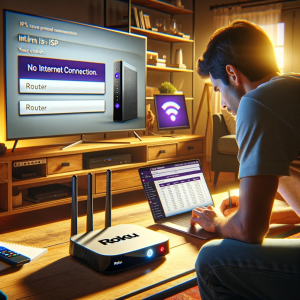
-
Ensure Roku Software is Up to Date
Keeping your Roku’s software updated is crucial for its optimal performance and security. Updates often include patches for known bugs that could be causing your Roku connectivity issues. To check for updates:
-
- Go to the Home menu by pressing the Home button on your Roku remote.
- Navigate to ‘Settings’ and then ‘System’.
- Select ‘System Update’ to see if your device is up to date. If not, follow the on-screen steps to install the latest update.
An outdated system might be the reason for Roku connected but not working properly, especially if it seems to be linked to internet or app-specific issues. To know more about not working issue, you can read our in-depth blog on Roku Not Working.
-
Check Other Devices on the Same Network as Roku
If you are experiencing Roku connectivity problems, it’s a good idea to check other devices connected to the same network. Are they also having trouble connecting to the internet? This can help determine whether the issue is with the Roku device itself or a broader network problem. If other devices are working fine, the focus can remain on troubleshooting Roku specifically; otherwise, you might need to look at your router or service provider.
-
Check for Service Outages for Roku
Sometimes the problem could be outside of your control, such as a service breakdown from your internet provider. These breakdowns can temporarily affect how is your Roku connected but not working issues manifest.
-
- Visit your ISP’s website on a different device to check for any announcements regarding outages.
- Contact Customer Service for real-time information about service disruptions.
- Use outage checker websites that can inform if there’s a local outage affecting your area.
Performing these initial checks saves time and directs your troubleshooting efforts more effectively. They are essential steps in resolving Roku not connecting to WiFi issues and should always be the first course of action when you notice your Roku device isn’t performing as expected.
Basic Troubleshooting for Roku Connectivity Issues
When your Roku device encounters issues such as Roku not connecting to WiFi, taking some basic troubleshooting steps can often resolve the problem quickly and restore your access to uninterrupted streaming. Here’s a detailed guide to basic troubleshooting when your Roku is not connecting to WiFi:
-
Restarting Your Roku Device
A simple restart can sometimes fix minor glitches and software bugs that may be causing Roku connectivity issues. To restart your Roku:
-
- Hold down the Home button on your Roku remote control..
- Go to Settings > System > System restart.
- Select Restart and allow the Roku device to reboot.
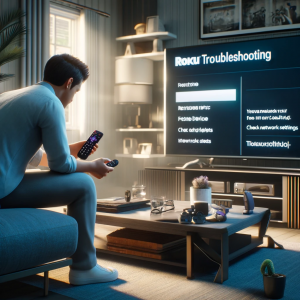 This process can refresh your device’s system and potentially clear up any issues that were preventing it from connecting to your WiFi network. If your Roku device restarts unexpectedly, you can read our comprehensive blog on Roku Keeps Restarting.
This process can refresh your device’s system and potentially clear up any issues that were preventing it from connecting to your WiFi network. If your Roku device restarts unexpectedly, you can read our comprehensive blog on Roku Keeps Restarting.
-
Rebooting Your Modem and Router for Roku
If restarting doesn’t help with Roku connectivity issues, the next thing to do is to reboot your modem and router. This can resolve network connectivity issues not just for your Roku, but for all devices on your network. To reboot the modem and router:
-
- Unplug the power cables from both modem and router.
- Wait for about at 30 seconds before plugging them back in. This pause is crucial as it clears the router’s memory and resets tasks that might have stalled.
- Turn on the modem and router and wait for them to fully restart. This may take a few minutes.
- Once your network is back up, try connecting your Roku device again.
-
Checking Roku’s Network Settings
Still if your Roku is not connecting to WiFi after a restart and router reboot, you should check the network settings on your Roku device to ensure it is set up correctly:
-
- Hold down the Home button on your Roku remote.
- Navigate to Settings > Network > Set up connection.
- Choose Wireless, and then let the Roku scan for available networks.
- Select your WiFi network from the list, fill the correct password (if your network is secured), and connect.
Make sure you are choosing the correct network and entering the right password. Selecting the wrong network can be the reason for Roku not connecting to WiFi.
These basic steps are often effective in resolving common connectivity issues with Roku devices. If your Roku is not connecting to WiFi after following these steps, it may be time to delve into more advanced troubleshooting techniques.
Advanced Tips for Roku Connectivity Issues
If basic troubleshooting hasn’t resolved the issue and your Roku is not connecting to WiFi or internet, advanced steps may be necessary. These techniques involve deeper adjustments to your network settings and equipment to ensure optimal performance and connectivity. Here’s how you can proceed: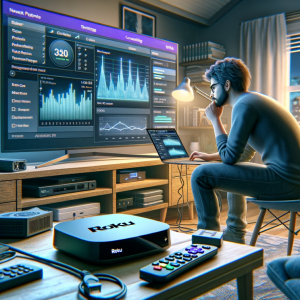
-
Changing DNS Settings for Roku
The Domain Name System (DNS) is like a phone book for the internet, converting web addresses into IP addresses. Sometimes, the DNS servers provided by your ISP may not perform optimally, leading to Roku connection problems. Changing the DNS settings on your network can often give a more stable and faster connection. Here’s how to change the DNS settings on your router:
-
- Access the settings of router by entering its IP address into a web browser.
- Login with your admin username and password.
- Locate the DNS settings under sections such as Network Setup or WAN Settings.
- Change the DNS entries to a more reliable service like Google DNS (8.8.8.8 and 8.8.4.4) or OpenDNS (208.67.222.222 and 208.67.220.220).
- Keep the changes and restart your router to apply new settings.
By switching to a different DNS, you may resolve the Roku not connecting to WiFi issue, as these services often provide faster and more reliable connectivity.
-
Adjusting Router’s Bandwidth Settings for Roku
If several devices are using your network simultaneously, your Roku device might not be getting enough bandwidth to connect to the internet. You can manage your router’s bandwidth settings to prioritize your Roku device:
-
- Log into your router’s admin panel as detailed above.
- Look for Quality of Service (QoS) settings.
- Within QoS, set up rules to prioritize traffic to your Roku device by its IP address, or prioritize the service type, such as streaming.
- Save these settings and monitor your Roku for any improvement in connection stability.
This adjustment can help to ensure that your Roku gets enough bandwidth, especially during peak usage times, thus reducing Roku connection problems.
-
Updating Router’s Firmware for Roku
Outdated firmware can lead to safety vulnerabilities and Roku connectivity issues. Updating your router’s firmware can enhance its performance and compatibility with devices like Roku:
-
- Access your router’s admin interface using the browser.
- Locate the firmware update section, often found under Administration, System, or Advanced settings.
- Check for any available updates and follow the instructions to download and install them.
- Restart the router after updating to ensure all new configurations take effect.
Keeping your router updated is crucial for maintaining a stable network environment, which can help solve issues where the Roku is not connecting to WiFi.
Wireless Specific Solutions for Roku
Wireless connectivity issues are common with streaming devices, including scenarios where your Roku is not connecting to WiFi. Addressing this concern involves optimizing your wireless network’s performance through proper placement of your device, minimizing interference, and potentially upgrading to a 5GHz network. These steps can help ensure a stable and robust connection for uninterrupted streaming.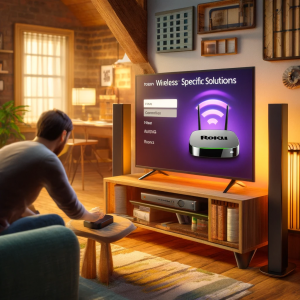
-
Optimal Placement of Roku Device
The placement of your Roku device can significantly impact its ability to connect to WiFi. To improve your Roku’s WiFi reception:
-
- Position your Roku device so that it is within a clear line of sight to your WiFi router. Avoid placing the Roku inside a TV cabinet or behind the TV where obstructions can block the signal.
- Elevate the Roku device and the router off the floor, ideally placing them atop shelves or cabinets.
- Keep the Roku away from other electronics that can cause electromagnetic interference, such as microwaves, cordless phones, and baby monitors.
Proper positioning can reduce connectivity problems and is particularly crucial when your Roku is not connecting to WiFi.
-
Reducing Interference for Roku
Wireless interference from other devices and networks can severely degrade your WiFi signal. To reduce interference and improve your Roku’s internet connection:
-
- Change the WiFi channel on your router. Most routers are set to auto-select the channel, but manually selecting a less congested channel can improve performance. Use WiFi analyzer tools available for smartphones to find the least crowded channel.
- Turn off other devices that may interfere with the WiFi signal when you’re using Roku, especially if these devices are known to use the same frequency band.
Minimizing interference is essential, especially in densely populated areas where many networks might overlap, often being the hidden culprit when Roku won’t connect to WiFi.
-
Using a 5GHz Network for Roku
If your router supports dual-band connections, switching your Roku to a 5GHz network can provide several benefits:
-
- The 5GHz band is typically less congested than the 2.4GHz band, which is commonly used by a variety of household electronics. This can lead to a cleaner and more stable connection.
- 5GHz offers higher speeds, which is advantageous for streaming high-definition content on your Roku.
To connect your Roku to a 5GHz network:
-
- Ensure your Roku supports 5GHz WiFi (newer models generally do).
- Separate the SSIDs (network names) for 2.4GHz and 5GHz on your router to easily identify and connect to the correct band.
- Select the 5GHz network during the WiFi setup process on your Roku.
Switching to a 5GHz network can often resolve issues like Roku TV not connecting to WiFi and enhance your streaming experience by reducing interruptions and buffering.
FAQs
Q1. Why is my Roku Not Connecting to WiFi?
A1. If your Roku is not connecting to WiFi, check to ensure your network settings are correct, your software is up-to-date, and there are no ISP outages. Also, restart your Roku and networking equipment as a basic troubleshooting step.
Q2. What should I do if my Roku Won’t Connect to internet but other devices will?
A2. If your Roku won t connect to internet but other devices will, focus on specific Roku-related solutions such as restarting your Roku device, checking for software updates, and ensuring the network settings on your Roku are correctly configured.
Q3. How do I update my Roku if it’s not connecting to the internet?
A3. If your Roku is not connecting to the internet, you can try connecting it temporarily to a different network to perform an update. Alternatively, check if using a wired Ethernet connection resolves the issue.
Q4. Why is my Roku not connecting to WiFi even after a router restart?
A4. If your Roku is not connecting to WiFi even after a router restart, try changing the DNS settings on your router, or adjust the Quality of Service (QoS) settings to prioritize your Roku device. It’s also beneficial to check for physical obstructions that might be blocking the signal.
Q5. Can changing the DNS settings on my router help my Roku connect to the internet?
A5. Yes, changing the DNS settings to a more reliable service like Google DNS or OpenDNS can help resolve Roku connectivity issues by improving the speed and stability of your internet connection.
Q6. How do I perform a factory reset to fix Roku connectivity issues?
A6. To factory reset your Roku, navigate to Settings > System > Advanced system settings > Factory reset, and follow the on-screen instructions to reset your device.
Conclusion
To ensure your Roku device maintains a reliable connection, allowing for seamless streaming, it’s important to systematically approach troubleshooting. Start with simple checks like updating Roku’s software, verifying other devices’ internet connectivity, and checking for service provider outages. If these don’t resolve the Roku connectivity issues, a restart of both your Roku and networking equipment might be necessary to clear any temporary connectivity hitches. Double-check your network settings to ensure the Roku is connected to the correct network with the right password—common oversights that can lead to Roku connectivity issues. If problems persist, consider delving deeper by updating your router’s firmware, changing its DNS settings, and optimizing bandwidth via Quality of Service (QoS) settings. Additionally, improve the physical setup to minimize interference and consider switching to a 5GHz WiFi network if congestion is a problem. Should these steps fail to rectify the Roku connection issues, a hardware problem may be at play; assess for any visible damage or attempt a factory reset as a last resort. Still, if your Roku is not connecting to WiFi after these efforts, professional help from Roku’s customer support might be necessary. By applying these instructions, you can effectively tackle most Roku connectivity issues, ensuring that your streaming experience remains uninterrupted.
To know more about Roku Not Connecting To Internet and other issues, visit our Roku Support Page.


Brian walker
What should I do if my Roku TV not connecting to WiFi, even though other devices have no connectivity issues?
Support Admin
When facing an issue where your Roku TV is not connecting to WiFi, the first step is to check if it’s an isolated problem with the Roku or a broader network issue. Start by ensuring your Roku’s software is up-to-date; outdated firmware can sometimes hinder connectivity. If updates are needed, connect your Roku to a different network, such as a mobile hotspot, to perform the update. Next, assess the placement of your Roku device. It should have a clear line of sight to the router, and try to minimize interference by keeping it away from other electronic devices like microwaves and cordless phones. If these steps don’t resolve the issue, perform a system restart on both your Roku device and your router. Changing the wireless channel on your router to a less congested one can also help improve connectivity during peak usage times.
Daniel young
My Roku device indicates it is connected to the internet but fails to stream content. What troubleshooting steps should I take?
Support Admin
If your Roku device indicates it is connected to the internet but streaming is not possible, this might suggest bandwidth issues or service interruptions. Check for any reported service outages that could be affecting your area. You can do this through your ISP’s website or dedicated outage checker websites. Ensure your internet speed meets Roku’s requirements—minimum of 3 Mbps for SD content and 25 Mbps for 4K streaming. If the speed is adequate, try restarting your Roku device and your networking equipment, which can resolve temporary glitches. For persistent issues, consider changing the DNS settings on your router to services like Google DNS or OpenDNS, which can provide a more stable and faster connection.